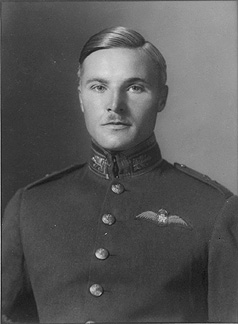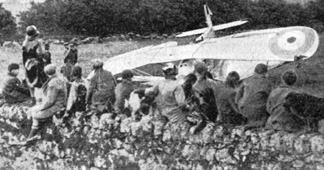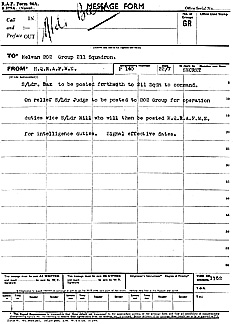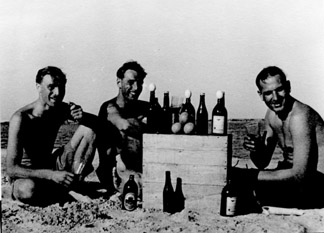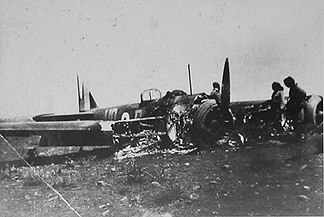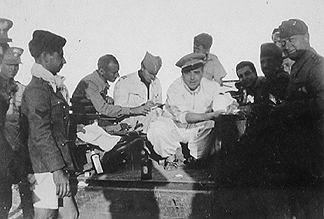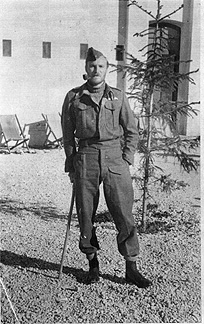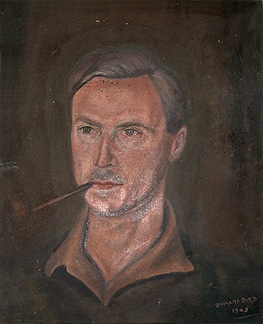 |
 |
||||||||
|
Squadron Leader ARG Bax 33018 RAF 1913—1999 Alfonso Rudolf Gordon Bax, otherwise “Porpoise” in service or plain Gordon to family, was born at Boscastle in Cornwall on 23 March 1913. Bax, who had begun flying as early as 1931 as an RAF Cranwell cadet, was commissioned in December 1932.
Gordon Bax in the 1920-pattern ceremonial Full Dress uniform of Pilot Officers, Flying Officers and Flight Lieutenants, shown by the five gold-wire oak leaves at the collar. Just a hint of a smile in this formal portrait from the noted Elliott & Fry studio, apparently taken on his commission as a Pilot Officer in December 1932. For many decades Eliott & Fry photographed notable figures of the day: Wilde, Shaw, Asquith, Elgar, Rosalind Franklin—all were sitters. Although the Baker Street studio and much of the image archive were destroyed by enemy action in 1942, the firm remained active under its own name until its centenary year, 1963. On silver wings
The scene the next day, with schoolchildren an avid audience on the drystone wall. The accident was well-covered by the local Press. Bax and his Air Gunner AC CN John escaped with some injury and were able to extricate themselves from the wreck. At the nearby prison they were given first aid before being taken to RN Hospital Stonehouse at Plymouth to recover. Dismantling and retrieval of the aircraft was carried out the next day. Later repaired, for a time it was at the RAF College before being reduced to maintenance airframe 800M in April 1936. Bax was promoted to Flying Officer with effect from 17 Jun 1934 in the London Gazette of 7 August 1934. By mid 1935 he had been long enough posted to XIII Squadron, by then at Old Sarum and still equipped with the Hawker Audax, to be presented with a magnificent sterling silver cigarette-box. F/O Bax was about to be posted overseas, then more than something of an adventure. With departure imminent and nothing loth, he put the question to Gwen, daughter of his old school headmaster. Engraved with the Squadron winged dagger emblem, the signatures of his fellow officers, his own initials and the date 28 August 1935, the silver box is part of their loot: their wedding gift from his old Squadron. It remains in the family today. By September 1935 he had taken up duty with No 208 (Army Co-operation) Squadron, a Middle East unit since 1920 and at Heliopolis as early as 1927. There, as Bax arrived, they, too, were re-equipping with the Audax. In the Spring of 1936, RAF expansion was gathering pace at Home. In Egypt, he took a brief stint with 64 Squadron and the Hawker Demon two-seat fighters, then it was back to the United Kingdom, first to a posting with 18 Squadron in June 1936 at Bircham Newton, this time equipped with Hawker Hinds. In October he was made up to Flight Lieutenant and shortly afterwards posted to 11 FTS at RAF Wittering, Northants where his varied Hawker skills could be put to good use with the Hart and Audax trainers on charge. Bax remained there until April 1939, gaining successively higher levels of classification as an instructor. As war became inevitable, his now considerable experience was recognised with promotion to Squadron Leader (London Gazette 4 April) on posting to 51 Army Co-operation Wing at Andover. Back to the Middle East By May 1940 the situation at Home was starting to look grim and the Middle East was on the very brink of hostilities. Bax got himself posted to No 70 (Bomber Transport) Squadron at RAF Helwan, where they were toiling away with their ageing Vickers Valentias. When war came at last, on 10 June, he was certainly on the spot. About this time, the CO of No 112 (Fighter) Squadron (S/Ldr DM Somerville 32113, later A/Cdr Somerville OBE) suffered burns to his face and hands when his Gloster Gladiator caught fire in the course of an army co-operation exercise near Heliopolis on the northern outskirts of Cairo. Somerville baled out and was quickly rescued to be admitted to 2/10 General Hospital, Helmieh, in Cairo. Although available records differ somewhat, it seems most likely that it was Gladiator I K8024, which had been taken on charge in May 1939 and was the Squadron’s first to fly. Certainly K8024 is of the right batch for 112 Squadron aircraft at the time and is the only Squadron Gladiator shown as abandoned afire in mid 1940. Accounts of the date of this incident also differ, by some margin. The Squadron’s own later published history reports Somerville’s narrow escape as 15 March 1940 (perhaps from a transcription error), while the Air Britain account reports it correctly as 15 April but as 2 miles South of Helwan, where the Squadron was based. Joe Fraser in March of the Gladiators also gave slightly differing details, recalling it as an aerobatic display. The Squadron Operations Record Book (TNA AIR 27/872) at least makes the order of events quite clear: 15 April 1940 F/Lt Williams signed the Operations Record Book sheets for April as officer commanding. 23 May 1940 Bax’s fighter experience at this point had been brief and he had never flown a single-seater operationally. However, he was soon extracted from 70 Squadron and given temporary command of the fighter squadron while Somerville recuperated. The ORB sheets for May were thus signed in the unmistakable hand of ARG Bax, “Squadron Leader, Commanding, 112 Squadron”. His presence is otherwise unremarked in the record, other than as an addressee (and that as S/Ldr 70 Squadron!) for the 1 June Movement Order detaching ‘B’ Flight to Sinkat in The Sudan (TNA AIR 27/876). Perhaps he picked up his copy as he met the 112 Squadron Adjutant that day! Taking up the 112 Squadron attachment on 1 June 1940 according to his Log Book, between 5 June and 7 June he made two practice flights (one in Gladiator K6138 and one in Gauntlet K7861) and on 14 June an engine test in Gladiator K7895. He was ready. Between 16 June and 20 June he took on 6 defensive patrols in the various available Gladiators, to report “nothing seen”. By now Somerville was on the mend and when the Form 540 sheets for June were ready, he had resumed duty, signing firmly as “Squadron Leader, Commanding, 112 Squadron”. For Bax, it was back to the Helwan Ops Room, but not for long. To the Greyhounds
“S/Ldr Bax to be posted forthwith to 211 Sqdn to command”. While the operational records of the Squadron from June up to 10 July are scant, thereafter the record is more complete. It seems that in just under six weeks with the 211s, he took just three flights in late July to convert himself to the Blenheim and get his eye in with the bombing, and then right into it. In just four weeks from 3 Aug 1940 to his forced landing on 4 September, Bax had flown 10 operations—a rate of work suggestive of "leading from the front"—while his Flight commanders were likewise clocking up ops quickly. On three occasions Bax and his crew mounted two sorties in a single day, the last of these being those of 4 September. His first six recorded ops were with Sgts Bain (Observer) and Shimmin (Gunner), in five different aircraft. His last four operations were flown with Bain as Observer and AC1 Wise as Gunner, all in L8376, which was clearly UQ-D "The Porpoise".
“A furious air duel...” Sgt Bain was another old Middle East hand: as Corporal with another Squadron, he'd been among those mentioned "in recognition of distinguished services rendered in connection with the operations in Palestine during the period 12th September 1937 to 31st March 1938" (London Gazette 23 December 1938). He was commissioned, after the war, in the Equipment Branch. The second aircraft, L8471, was piloted by F/Sgt Marpole with P/O Smith (very possibly Observer Eric Bevington-Smith) and LAC Alcock in the turret. Commonly, such raids first took a seaward course then a final dog-leg to the target.The pair arrived over Derna to bomb from 16,000ft at about 1515hrs. At about 1520hrs, they came under persistent and prolonged attack from astern by a single Fiat CR.42 biplane of 92a Squadriglia flown by Sergente Ernesto Pavan, who had scrambled alone from Derna to intercept. Diving down on the Blenheims from about 500ft above, for the next 5 or 8 minutes (a long time in an air fight) Pavan first attacked the No 2 or Port aircraft (Marpole & co in L8471) and, when shaken off, Bax & co in the lead aircraft L8376. In the turret of L8471, LAC Alcock had returned fire, expending some 200 rounds (changing the 100-round pans in action) to beat off the Italian. As Pavan turned his attack to Bax & co, Marpole was able to make two diving passes at the Italian but his front gun (the wing-mounted Browning) failed to fire: one of Pavan’s hits had pierced the ammunition tank breaking the ammunition belt. In all, Marpole’s aircraft took a total of nine machine gun hits, two through the Port main spar, a small splinter hole in the starboard petrol tank, and a leak in the Port oil tank. They were able to reach Sidi Barrani to forced-land safely at about 1625hrs. Recovered, repaired and returned to service, L8471 was lost in Greece with 84 Squadron on 22 December 1940 in an operation over Kucera (Kucove) during which F/O Miles, Sgt Moir and Sgt Brooker were shot down by Fiat G.50s. They are remembered on the Alamein Memorial. Bax in L8376 had rather more terminal damage to deal with. The oil system was hit and first the starboard engine seized, as observed by Marpole. Soon the port engine failed too but Bax was able to safely forced-land near Derna airfield, to be taken PoW along with his crew. Their aircraft was later strafed on the ground and caught fire.
Bax and Co’s aircraft, L8376, examined by Italian servicemen. "Near Derna, Squadron Leader Bax, flying his aircraft with the porpoise and the words "There's a porpoise close behind you" emblazoned on its side, had been shot down by a fighter....Bax had been with the squadron only a month but had endeared himself to all....Months afterwards we heard the glad news that Bax was a prisoner of war. He wrote the Squadron a cheery letter, asking about his kit....". T Wisdom Wings Over Olympus p40
The cheerful hatted figure, centre, is the 92a Squadriglia pilot Sergente Ernesto Pavan of the Regia Aeronutica, who shot them down. Bax, centre rear, in white flying suit with cigarette intent on signing something—an autograph, perhaps? Pavan’s account, which differs in a number of details, was that having shot down one aircraft, he followed the second (ie of Marpole & co) and shot it down over the sea. He landed at Derna having expended 1,000 rounds of ammunition with his aircraft damaged by return fire from the Blenheims. A full account of Pavan’s RA service is given on Håkan Gustavsson's Biplane Fighter Aces site, http://surfcity.kund.dalnet.se/italy_pavan.htm. The account given here is that from the 211 Squadron perspective, as recorded in the Squadron diary and Marpole’s combat report, with Wisdom’s and Squire’s accounts which are independent and reasonably consistent with the records. What is also clear from Squire and Wisdom is the affection with which 211 Squadron regarded Bax.
Leaning heavily on a stick, the composure somewhat grimmer now. His leg, broken in the forced-landing, had been reset in Italy, likely the scene of this shot. In August 1945, Bax received a letter from a family of Sulmona in the mountains of central Italy, enclosing a photograph of him from the PoW camp there, Campo PG78. This may be that photograph. As the Allied forces advanced up through Italy Bax was moved to Germany. A later captive, Sgt John Beharrel, was similarly unlucky.
Douglas Bird’s portrait of “Porpoise” while a PoW in Germany. Bax was able to send it home—the address is still on the back. Pipe-smoking again, with a hint of insouciance in the smoke rings, though a PoWs life was far from easy. At the end of the war he was in Stalag Luft I, at Barth on the Baltic coast of Pomerania. Interestingly, there was more than one Bax in RAF WWII service. Perhaps that accounts for two oddities in the reporting of his PoW experience:
In any event, some years after the War, Pavan took the trouble to find Bax, writing to the Air Ministry to seek him by referring to their “furious air duel over Derna”. Passed on by Air Historical Branch, Bax replied to his enquiry and the pair were able to meet in London. The two Derna photographs were given to Bax by Pavan at this time, and the family continued to receive cards from him each Christmas and Easter thereafter. Ernesto Pavan passed away in 2006. Post-war service Peace-time re-arrangements could be testing even for pre-war men on permanent commissions but Bax survived all that, with a temporary stint as Wing Commander in 1947 followed by substantive W/Cdr rank in July 1949. He carried on in the Secretarial Branch until his retirement due to ill-health in September 1955, having given 24 years service to his country and his Sovereign in peace, war and captivity. Retiring to Boscastle, he and Gwen were able to buy the St Juliot Rectory where her own father had been Rector. There he kept contentedly busy, with three acres of garden to look after and duties as both church warden and bell-ringer—a particularly English musical interest that has passed on down the family. In between, there were family holidays fly-fishing in Scotland, and driving the sports car he kept right to the end of his life. In later years, he took much pleasure in commissioning a series of magnificent paintings of the aircraft he had flown in the RAF. For his 85th birthday in 1998, the family arranged a flight in a Tiger Moth, the first time he had flown since 1940. He was suitably impressed. When the pilot realised that it was the first time Bax had flown from a paved runway, he agreed that grass was better so they tried both. Afterwards, the pilot remarked that other than the first couple of minutes he had barely touched the controls, leaving most of it to his “passenger”. AR Gordon Bax, Squadron Leader, bell-ringer, fly-fisherman, gardener and church warden, died in April 1999. His wife Gwen had passed away in 1997. Put in touch by Adrian Fryatt, grand-daughter Sally Searle and her mother have shared most generously of the wonderful memorabilia that Gordon left to them. In the Old Rectory, Sally and her husband Chris have made their home and their business. Sources Air Force List issues 1932 to 1955. R Brown Shark Squadron (Crecy 1994)
www.211squadron.org © D Clark & others 1998—2025 |
||||||||
